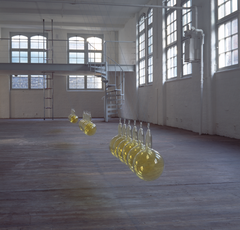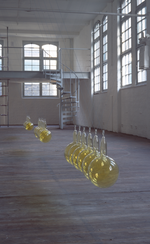Place of birth
Location(s)
W5 1BN
United Kingdom Ilford, London
IG1 1NG
United Kingdom Goldsmiths, University of London
SE14 6NW
United Kingdom
Place of death
London
About
Hamad Butt was born in Lahore, Pakistan and moved to east London with his family at the age of 2. He spent his childhood in Ilford and Manor Park. He travelled to Pakistan once, spending around a year in Lahore with his family in the late 1960s, before returning to live in London. He was raised in the Muslim faith, and although he renounced Islam in his teens, he retained a cerebral interest in Islamic ritual and iconography, architecture, classical theology and esotericism (including alchemy), and Sufi mysticism and poetry. These would recur in his works on paper in the 1980s and his sculptural installations in the early 1990s.
Butt studied extensively. He began a biochemistry degree at Westfield College in 1980 but left the course to pursue a career as an artist. He undertook a foundation degree in fine art at Goldsmiths’ College (1981–2), followed by a degree in fine art at North-East London Polytechnic (1982–4), from which he also withdrew. Butt undertook extensive training in traditional techniques through short courses in printmaking, drawing and painting, and completed a degree in fine art at Goldsmiths’ College (1987–90). His time at Goldsmiths' coincided with that of many of the artists who would come to be known as the Young British Artists, a group of commercially aspirational and media-savvy artists, many of whom were white and heterosexual. Butt did not participate in their exhibitions nor is he considered part of this trend, though he is often discussed as adjacent or oppositional to them.
In the 1980s Butt was a prolific maker of works on paper, including prints and drawings, as well as paintings and small-scale sculptures. His works from this period were generally figurative and expressionistic, and often displayed debts to canonical European modernism, including through styles borrowed from Pablo Picasso and Henri Matisse. By 1990, under the influence of teachers at Goldsmiths' including Sarat Maharaj, Jean Fisher and Jon Thompson, Butt jettisoned these practices for a strikingly novel mode of large-scale sculpture. His signature works include Transmission (1990) and Familiars (1992). Transmission includes a ring of nine books constructed from glass and steel and lit by ultraviolet lamps installed as the spines. The circle recalls the arrangement of a Qur'anic reading circle for a khatēm, an Islamic funerary ceremony, and the stands recall the rehal upon which a Qur'an rests. The glass pages are engraved with a drawing of a triffid, a monstrous man-eating plant invented by John Wyndham in his popular sci-fi novel (and later film and television series) The Day of the Triffids (1951). The books were accompanied by a glass-fronted wooden case filled with live flies, a series of prophetic texts and an animated video. His final series, Familiars, is perhaps his most ambitious. It consists of three volatile-seeming sculptures in which three dangerous chemical elements are held in vacuum-sealed glass. In Hypostasis, three bowed steel tubes are positioned to resemble an arch. The tubes are tipped with long thin glass vials filled with liquid bromine, an irritant that is both corrosive and carcinogenic. Cradle consists of between nine and eighteen glass spheres, each of which is filled with acid-yellow chlorine gas and suspended on long steel cords. They hang together to resemble a Newton’s Cradle and appear to invite interaction. Taking up the invitation would be deadly. In Substance Sublimation Unit, nine glass vials are installed in a vertical series between two steel poles. Each vial contains solid bromine crystals and a heating element. The elements are heated in an ascending series. As each element glows orange-red, the crystals are prompted to sublimate: that is, the dense grey-black turns directly from a solid to an ominous violet gas.
Butt was unable to make new works after 1992. He became progressively more ill and died of AIDS-related bronchopneumonia at St Mary’s Hospital in Paddington, London, aged just 32. His work was shown posthumously in the major group show Rites of Passage: Art for the End of the Century at Tate Gallery in 1995. However, his work was rarely shown subsequently. Butt has recently been the subject of various attempts to recover and reposition his work as one of the most dynamic practices of British art in the 1990s, including through the Tate’s acquisitions of Transmission and Familiars (in 2019 and 2014, respectively); the inclusion of Transmission in the rehang of Tate’s permanent collection at Tate Britain in 2022; and a major touring retrospective of Butt’s work at Irish Museum of Modern Art, Dublin and Whitechapel Gallery, London in 2024–5.
Jean Fisher, Sarat Maharaj.
Rites of Passage: Art for the End of the Century (curated by Stuart Morgan and Frances Morris), Tate Gallery, 1995
000 Zero Zero Zero: British-Asian Cultural Provocateurs (curated by Ilze Stradina and Gavin Fernandes), Whitechapel Gallery, London, 1999
Alien Nation (curated by John Gill, Jens Hoffmann and Gilane Tawadros), Institute of Contemporary Arts, London; Manchester Art Gallery, Manchester; Sainsbury Centre for Visual Arts, Norwich, 2006
Fisher, Jean, ‘Vitrines from the Pathology Museum’, in Vampire in the Text: Narratives of Contemporary Art (London: Institute of International Visual Arts, 2003), pp. 258–65
Foster, Stephen (ed.) Hamad Butt: Familiars (London and Southampton: Institute of International Visual Arts and John Hansard Gallery, 1995)
Fullerton, Elizabeth, Artrage! The Inside Story of the BritArt Revolution (London: Thames & Hudson, 2016)
Johnson, Dominic (ed.) Hamad Butt: Apprehensions (Munich and London: Prestel and Whitechapel Gallery, 2025)
Mercer, Kobena, ‘Ethnicity and Internationality’, Third Text 13.49 (1999), pp. 51–62.
Morgan, Stuart, ‘Hamad Butt’, in Stuart Morgan and Frances Morris (eds) Rites of Passage: Art for the End of the Century (London: Tate Gallery, 1995), pp. 64–7
Muir, Gregor, Lucky Kunst: The Rise and Fall of Young British Art (London: Aurum Press, 2011)
Page, Clement, ‘Hamad Butt: The Art of Metachemics’, Third Text 9.32 (1995), pp. 33–42
The Archive of Hamad Butt, Tate Archives London, TGA 201919
Banner image credit
Thurston Hopkins/Picture Post/Hulton Archives via Getty Images
Image credit
Hamad Butt, Familiars: Cradle (1992). © Jamal Butt. Used with permission
Entry credit
Dominic Johnson


